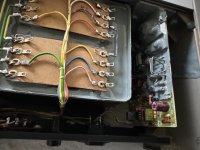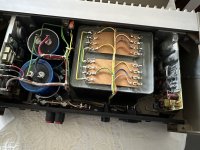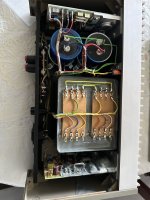Hi everyone
Greetings and best wishes for 2024
I had the opportunity to buy a slightly used 405-1 last week.
When tested it was found ok but of course I am planning for a recap / restoration.
So I opened it today for a preliminary inspection and to my dismay , the transformer grey silicon compound was molten and had leaked on one board (pcb) covering most components.
See attached photos. In the previous quads I worked on I did notice some semi-molten transformer compound but not like this !!
I would be most grateful if anyone could advise me how to remove this grey molten silicon compound from the board and also any method for curing/solidify the remaining compound inside the transformer
Thanks a lot
Regards
Greetings and best wishes for 2024
I had the opportunity to buy a slightly used 405-1 last week.
When tested it was found ok but of course I am planning for a recap / restoration.
So I opened it today for a preliminary inspection and to my dismay , the transformer grey silicon compound was molten and had leaked on one board (pcb) covering most components.
See attached photos. In the previous quads I worked on I did notice some semi-molten transformer compound but not like this !!
I would be most grateful if anyone could advise me how to remove this grey molten silicon compound from the board and also any method for curing/solidify the remaining compound inside the transformer
Thanks a lot
Regards
Attachments
Its called silicone, not silicon. That's pretty nasty - perhaps it will harden in the cold, allowing it to be peeled off? Or heat up and let it drip out? I fear it's full of metal particles to increase thermal conductivity (hence the colour), and this doesn't sound like a great idea to have on the PCB. However silicones are very inert, so its unlikely to be doing damage.
Thank you for your prompt reply and the rectification.
I believe it was stored upside down by the previous owner and gradually it leaked on the pcb and surroundings.
I believe it was stored upside down by the previous owner and gradually it leaked on the pcb and surroundings.
It's quite surprising, that's two people reporting this problem here on Diyaudio.
I have had to repair a good fifteen 405s and I have never seen this phenomenon, one wonders if it might not be a production series which poses a problem.
I have had to repair a good fifteen 405s and I have never seen this phenomenon, one wonders if it might not be a production series which poses a problem.
Looks like it was stored on its RH end, not upside down, and in a very hot environment. Or else it was operated that way and overheated for some reason.
i think I would try freezer spray and chip it off.
i think I would try freezer spray and chip it off.
To me, it looks like someone did the transformer potting after the fact (after testing) and then let the amp sit on it's side when the compound was still not cured hard enough. This stuff doesn't melt when hot, it decomposes, unless it's just potting wax like old-old-really old Fender Amps used to get drenched in. Then it needs just a hair dryer and a paper towel, but I doubt it is. If it is something like the standard potting (acrylic) epoxy used on hybrid ICs and weatherproofing, a bath in acetone may be a good idea, after a day or two (or a week) it just peels off. Taking in mind that all (rolled) film and electrolytic caps, trimpots and other stuff (fuse holders, relays) that may get damaged has to be swapped out afterwards.
This worked really well on those old Roland Juno modules...
If it is silicone, then silicone/caulk remover from the hardware store. I doubt that it is normal silicone, as it emits acid fumes when curing and can be nasty to electronics (acetic acid!!!).
This worked really well on those old Roland Juno modules...
If it is silicone, then silicone/caulk remover from the hardware store. I doubt that it is normal silicone, as it emits acid fumes when curing and can be nasty to electronics (acetic acid!!!).
I know, I know... And is expensive as hell... 100€+ for one small tube of aviation grade silicone, used mostly on antennas. Not economical for potting consumer electronics.
But that grey goo looks more like standard potting compound, but grey instead of black.at least it is not silicone putty, the half liquid kind used for ECUs and, sometimes, waterproofing junction boxes that will go underwater. I hate that gunk...
I would check with acetone first, then on to nastier stuff.
But that grey goo looks more like standard potting compound, but grey instead of black.at least it is not silicone putty, the half liquid kind used for ECUs and, sometimes, waterproofing junction boxes that will go underwater. I hate that gunk...
I would check with acetone first, then on to nastier stuff.
Thanks for that information, very interesting. There was another case of this last year here.This stuff doesn't melt when hot, it decomposes
I’ve serviced hundreds of 405s and never encountered it.
I to have serviced more than 100 405s and never seen this problem, I think the potting compound is a 2 part mix which may have gone wrong at the mixing stage. I am not aware of any solvent that will remove the potting, if you find one it would be useful to know as I could un-pot my large collection of buzzing transformers, they do at least make good weights with there rounded corners.
Stuart
Stuart
- Home
- Amplifiers
- Solid State
- QUAD 405 - Molten Transformer Grey compound



